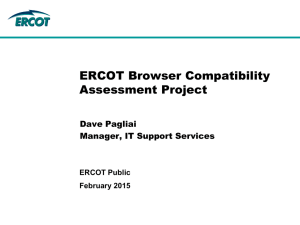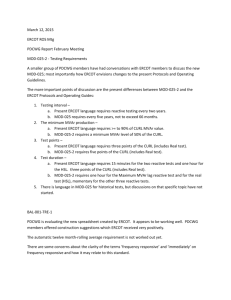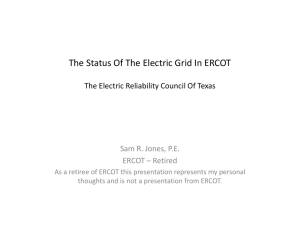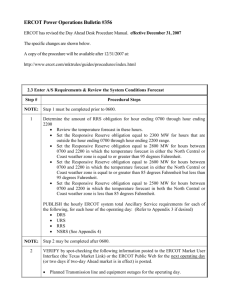DRAFT NPRR Data Class Changes
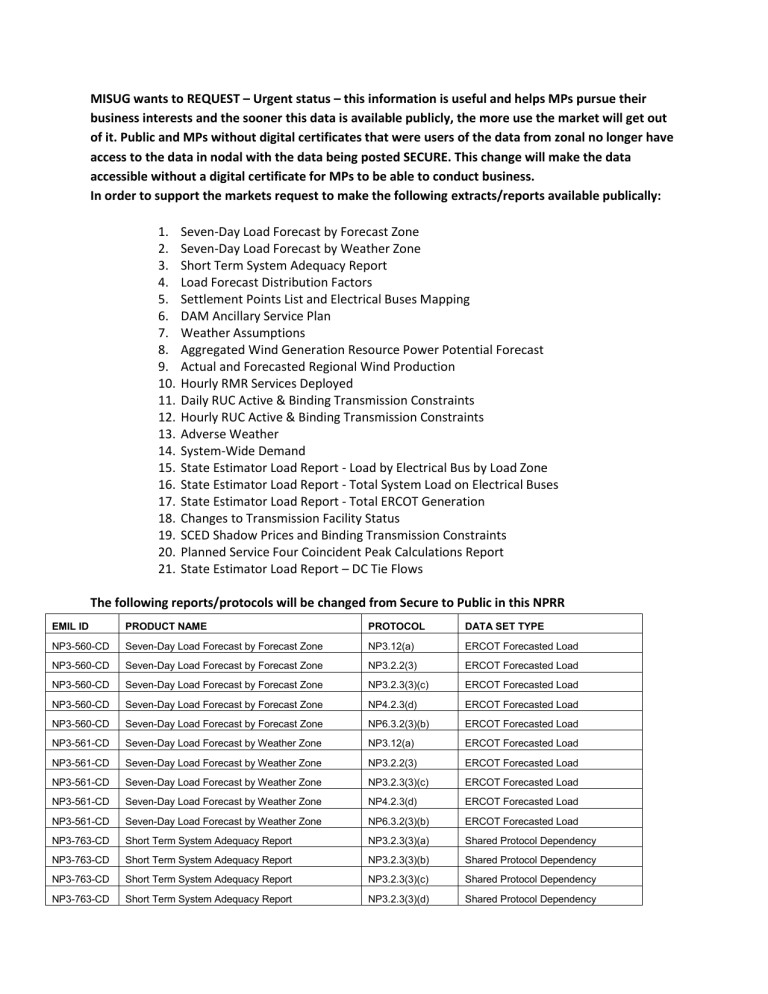
MISUG wants to REQUEST – Urgent status – this information is useful and helps MPs pursue their business interests and the sooner this data is available publicly, the more use the market will get out of it. Public and MPs without digital certificates that were users of the data from zonal no longer have access to the data in nodal with the data being posted SECURE. This change will make the data accessible without a digital certificate for MPs to be able to conduct business.
In order to support the markets request to make the following extracts/reports available publically:
1.
Seven-Day Load Forecast by Forecast Zone
2.
Seven-Day Load Forecast by Weather Zone
3.
Short Term System Adequacy Report
4.
Load Forecast Distribution Factors
5.
Settlement Points List and Electrical Buses Mapping
6.
DAM Ancillary Service Plan
7.
Weather Assumptions
8.
Aggregated Wind Generation Resource Power Potential Forecast
9.
Actual and Forecasted Regional Wind Production
10.
Hourly RMR Services Deployed
11.
Daily RUC Active & Binding Transmission Constraints
12.
Hourly RUC Active & Binding Transmission Constraints
13.
Adverse Weather
14.
System-Wide Demand
15.
State Estimator Load Report - Load by Electrical Bus by Load Zone
16.
State Estimator Load Report - Total System Load on Electrical Buses
17.
State Estimator Load Report - Total ERCOT Generation
18.
Changes to Transmission Facility Status
19.
SCED Shadow Prices and Binding Transmission Constraints
20.
Planned Service Four Coincident Peak Calculations Report
21.
State Estimator Load Report – DC Tie Flows
The following reports/protocols will be changed from Secure to Public in this NPRR
EMIL ID PRODUCT NAME
NP3-560-CD Seven-Day Load Forecast by Forecast Zone
NP3-560-CD Seven-Day Load Forecast by Forecast Zone
NP3-560-CD Seven-Day Load Forecast by Forecast Zone
NP3-560-CD Seven-Day Load Forecast by Forecast Zone
NP3-560-CD Seven-Day Load Forecast by Forecast Zone
NP3-561-CD Seven-Day Load Forecast by Weather Zone
NP3-561-CD Seven-Day Load Forecast by Weather Zone
NP3-561-CD Seven-Day Load Forecast by Weather Zone
NP3-561-CD Seven-Day Load Forecast by Weather Zone
NP3-561-CD Seven-Day Load Forecast by Weather Zone
NP3-763-CD Short Term System Adequacy Report
NP3-763-CD Short Term System Adequacy Report
NP3-763-CD Short Term System Adequacy Report
NP3-763-CD Short Term System Adequacy Report
PROTOCOL
NP3.12(a)
NP3.2.2(3)
NP3.2.3(3)(c)
NP4.2.3(d)
NP6.3.2(3)(b)
NP3.12(a)
NP3.2.2(3)
NP3.2.3(3)(c)
NP4.2.3(d)
NP6.3.2(3)(b)
NP3.2.3(3)(a)
NP3.2.3(3)(b)
NP3.2.3(3)(c)
NP3.2.3(3)(d)
DATA SET TYPE
ERCOT Forecasted Load
ERCOT Forecasted Load
ERCOT Forecasted Load
ERCOT Forecasted Load
ERCOT Forecasted Load
ERCOT Forecasted Load
ERCOT Forecasted Load
ERCOT Forecasted Load
ERCOT Forecasted Load
ERCOT Forecasted Load
Shared Protocol Dependency
Shared Protocol Dependency
Shared Protocol Dependency
Shared Protocol Dependency
NP3-763-CD Short Term System Adequacy Report
NP3-763-CD Short Term System Adequacy Report
NP4-159-CD Load Forecast Distribution Factors
NP4-159-CD Load Forecast Distribution Factors
Settlement Points List and Electrical Buses
NP4-160-SG Mapping
NP4-160-SG
Settlement Points List and Electrical Buses
Mapping
NP4-33-CD DAM Ancillary Service Plan
NP3.2.3(3)(e)
NP4.2.3(k)
NP6.3.2(3)(e)
NP4.2.3(e)
NP4.2.3(i)
Shared Protocol Dependency
Shared Protocol Dependency
Shared Protocol Dependency
Shared Protocol Dependency
Settlement Points
NP4-722-CD Weather Assumptions
NP4-730-SG
Aggregated Wind Generation Resource Power
Potential Forecast
NP4-732-CD Actual and Forecasted Regional Wind Production
NP5-108-CD Hourly RMR Services Deployed
Daily RUC Active & Binding Transmission
NP5-754-CD Constraints
NP5-755-CD
Hourly RUC Active & Binding Transmission
Constraints
NP6-18-AN Adverse Weather
NP6-235-CD System-Wide Demand
NP6-623-CD
State Estimator Load Report - Load by Electrical
Bus by Load Zone
NP6-624-CD
NP6-625-CD
State Estimator Load Report - Total System Load on Electrical Buses
State Estimator Load Report - Total ERCOT
Generation
NP6-626-CD State Estimator Load Report – DC Tie Flows
NP4.2.3(j)
NP3.2.3(3)(d)
NP4.2.3(b)
NP4.2.2(5)
NP4.2.2(6)
NP6.3.2(3)(c)
NP5.3(3)(b)(i)
NP5.3(3)(b)(i)
NP6.3.2(3)(a)(ii)
NP6.3.2(3)(d)
Settlement Points
Shared Protocol Dependency
Hourly Forecasted Temperatures by
Weather Zone
Short Term Wind Power Forecast
Aggregated Wind Generation
Resource Power Potential Forecast
Aggregated Wind Generation Output by Load Zone
Shared Protocol Dependency
Active Binding Constraints
Active Binding Constraints
Shared Protocol Dependency
Shared Protocol Dependency
NP6.5.7.1.13(4)(b) Real-Time Load by Load Zone
NP6.5.7.1.13(4)(b) Real-Time Total System Load
NP6.5.7.1.13(4)(b) Real-Time Aggregated Generation
NP6.5.7.1.13(4)(b) Real-Time DC Tie Flows
NP6-661-AN Changes to Transmission Facility Status
SCED Shadow Prices and Binding Transmission
NP6-86-CD Constraints
NP6-86-CD
SCED Shadow Prices and Binding Transmission
Constraints
NP6-86-CD
NP9-83-M
SCED Shadow Prices and Binding Transmission
Constraints
Planned Service Four Coincident Peak
Calculations Report
NP6.3.2(3)(a)(i)
NP6.3.2(2)
NP6.3.2(3)(e)
NP6.5.7.1.13(4)(d) Active Binding Constraints
NP9.17.1(1)
Shared Protocol Dependency
Active Binding Constraints
Active Binding Constraints
4 Coincident Peak Calculations
Protocol: NP3.12(a)
3.12 Load Forecasting
ERCOT shall produce and use Load forecasts to serve operations and planning objectives.
(a) ERCOT shall update and post hourly on the Market Information System (MIS)
Public Area a “Seven-Day Load Forecast” as described in Section 13.2.1, Seven-
Day Load Forecast, that provides forecasted hourly Load over the next 168 hours for each of the Weather Zones and for each of the Forecast Zones.
Protocol: NP3.2.2(3)
3.2.2 Demand Forecasts
(1) Monthly, ERCOT shall develop the weekly peak hour Demand forecast for the ERCOT
Region and for the Forecast Zones based on the 36-Month Load Forecast as described in
Section 3.12, Load Forecasting, for the following 36 months, starting with the second week. During the development of this forecast, ERCOT may consult with Qualified
Scheduling Entities (QSEs), Transmission Service Providers (TSPs), and other Market
Participants that may have knowledge of potential Load growth.
(2)
(3)
ERCOT may, at its discretion, publish on the MIS Secure Area, additional peak Demand analyses for periods beyond 36 months.
ERCOT shall develop and publish hourly on the MIS Public Area peak Demand forecasts by Forecast Zone for each hour of the next seven days using the Seven-Day Load
Forecast as described in Section 3.12.
(4)
(5)
For purposes of Demand forecasting, ERCOT may choose to use the same forecast as that used for the Load forecast.
ERCOT shall publish procedures describing the forecasting process on the MIS Public
Area.
Protocol: 6.3.2(3)
(3) At the beginning of each hour, ERCOT shall post on the MIS Public Area the following information:
(a) Changes in ERCOT System conditions that could affect the security and dynamic transmission limits of the ERCOT System, including:
(i) Changes or expected changes, in the status of Transmission Facilities as recorded in the Outage Scheduler for the remaining hours of the current
Operating Day and all hours of the next Operating Day; and
(ii) Any conditions such as adverse weather conditions as determined from the
ERCOT-designated weather service;
(b)
(c)
(d)
Updated system-wide Load forecasts;
The quantities of Reliability Must-Run (RMR) Services deployed by ERCOT for each previous hour of the current Operating Day;
Total ERCOT System Demand, from Real-Time operations, integrated over each
Settlement Interval; and
(e) Updated Electrical Bus Load distribution factors and other information necessary to forecast Electrical Bus Loads for each hour of the current Operating
Day and all hours of the next Operating Day.
3.2.3
(3)
System Adequacy Reports
ERCOT shall generate and post a “Short-Term System Adequacy Report” on the
MIS Public Area. ERCOT shall update this report hourly following updates to the
Seven-Day Load Forecast and on detection of a change to Resource Status that changes the availability of a Resource. The Short-Term System Adequacy Report will provide:
(a) For Generation Resources, the available On-Line Resource capacity for
(b)
(c) each hour, using the COP for the first seven days;
For Load Resources, the available capacity for each hour using the COP;
Forecast Demand for each hour described in Section 3.2.2;
(d)
(e)
Ancillary Service requirements for the Operating Day and subsequent days; and
Transmission constraints that have a high probability of being binding in
SCED or DAM given the forecasted system conditions for each week including the effects of any transmission or Resource Outages. The binding constraints may not be updated every hour.
4.2.3 Posting Secure Forecasted ERCOT System Conditions
(c)
(e)
(g)
(h)
No later than 0600 in the Day-Ahead, ERCOT shall post on the MIS Secure Area, and make available for download, the following information for the Operating Day:
(a) The Redacted Network Operations Model that includes known transmission line and other Transmission Facilities outages in the Common Information Model (CIM) format for the minimum Load hour and the peak Load hour, and the companion version of
Network Operations Model (unredacted) will be posted to the MIS Certified Area for
Transmission Service Providers (TSPs);
(b) Differences between the posted 0600 Redacted Network Operations Model and the previous day’s Redacted Network Operations Model;
(d) Any weather-related changes to the transmission contingency list;
(f)
Load Profiles for non-Interval Data Recorder (IDR) metered Customers;
Distribution Loss Factors (DLFs) and forecasted ERCOT-wide Transmission Loss Factors
(TLFs), as described in Section 13.3, Distribution Losses, and Section 13.2, Transmission
Losses, for each Settlement Interval of the Operating Day;
4.2.3.1 Posting Public Forecasted ERCOT System Conditions
No later than 0600 in the Day-Ahead, ERCOT shall post on the MIS Public Area, and make available for download, the following information for the Operating Day:
(a) Weather assumptions used by ERCOT to forecast ERCOT System conditions and used in the Dynamic Rating Processor;
(b)
(c)
(d)
(e)
(f)
ERCOT System, Weather Zone, and Load Zone Load forecasts for the next seven days, by hour, and a message on update indicating any changes to the forecasts by means of the Messaging System;
A current list of all Settlement Points that may be used for market processes and transactions;
A mapping of Settlement Points to Electrical Buses in the Network Operations Model;
A list of transmission constraints that have a high probability of binding in the Security-
Constrained Economic Dispatch (SCED) or DAM.
Load forecast distribution factors from which Market Participants can calculate Load at the Electrical Bus level by hour for the next seven days;
5.3 ERCOT Security Sequence Responsibilities
(1) ERCOT shall start the Day-Ahead Reliability Unit Commitment (DRUC) process at 1430 in the Day Ahead.
(2) For each DRUC, ERCOT shall use a snapshot of Resource commitments taken at 1430 in the Day Ahead to settle RUC charges. For each HRUC, ERCOT shall use a snapshot of
Resource commitments from each QSE’s most recently submitted COP before HRUC execution to settle RUC charges.
(3) For each RUC process, ERCOT shall:
(a) Execute the Security Sequence described in Section 5.5, Security Sequence,
Including RUC, including:
(i) Validating Three-Part Supply Offers, defined in Section 4.4.9.1, Three-Part
Supply Offers; and
(ii) Reviewing the Resource commitment recommendations made by the RUC algorithm; and
(b) Post to the MIS Secure Area, the following information related to the RUC:
(i)All Resources that were committed or decommitted by the RUC process; and
(c) Post to the MIS Public Area, the following information related to the RUC:
(i) All active and binding transmission constraints (contingency and overloaded element pair information where available) used as inputs to RUC
(d) Issue Dispatch Instructions to notify each QSE of its Resource commitments or decommittments.
4.2.2 Wind-Powered Generation Resource Production Potential
(5) Each hour, ERCOT shall post the STWPF 50% probability of exceedance forecast on the MIS Public Area. ERCOT shall retain the STWPF for each hour.
(6) ERCOT shall post to the MIS Public Area on a regional basis a rolling 48 hour actual wind power production and the forecasted amounts from the STWPF and the TEWPF.
Protocol: NP6.5.7.1.13(4)(b)
Data Inputs and Outputs for the Real-Time Sequence and SCED
(4) Every hour, ERCOT shall post on the MIS Secure Area the following information:
( a) Status of all breakers and switches used in the NSA except breakers and switches connecting Resources to the ERCOT Transmission Grid;
(c) All binding transmission constraints and the contingency or overloaded element pairs that caused such constraint;
(d) All Shadow Prices on binding transmission constraints;
(e) The 15-minute average of Loads on the Electrical Buses from State
Estimator results; and
(f) Shift Factors by Resource Node.
(8) Every hour, ERCOT shall post on the MIS Public Area the following information:
( a) Individual transmission Load on Electrical Buses, sum of the Load on each
Electrical Bus in each Load Zone, and total Load on Electrical Buses in the
ERCOT System, and the sum of ERCOT generation, and flow on the DC Ties, all from the State Estimator;
Report Name: SCED Shadow Prices and Binding Transmission Constraints
Emil ID: NP6-86-CD
Protocol: NP6.3.2(2)
Activities for Real-Time Operations
(2)The following table summarizes the timeline for the Operating Period and the activities of
QSEs and ERCOT during Real-Time operations where “T” represents any instant within the
Operating Hour. The table is intended to be only a general guide and not controlling language, and any conflict between this table and another section of the Protocols is controlled by the other section:
Operating Period QSE Activities ERCOT Activities
During the first hour of the Operating
Period
Execute the Hour-Ahead Sequence, including HRUC, beginning with the second hour of the Operating Period
Review and communicate HRUC
Operating Period QSE Activities ERCOT Activities
Before the start of each Security-
Constrained
Economic Dispatch
(SCED) run
SCED run
During the Operating
Hour
Update Output Schedules for DSRs
Acknowledge receipt of Dispatch
Instructions
Comply with Dispatch Instruction
Review Resource Status to assure current state of the Resources is properly telemetered
Update COP with actual Resource Status and limits and Ancillary Service
Schedules
Communicate Resource Forced Outages to ERCOT commitments
Snapshot the Scheduled Power Consumption for Controllable Load Resources
Validate Output Schedules for DSRs
Execute Real-Time Sequence
Execute SCED
Communicate all Base Points, Dispatch
Instructions and LMPs for energy and
Ancillary Services using Inter-Control
Center Communications Protocol (ICCP) or
Verbal Dispatch Instructions (VDIs)
Monitor Resource Status and identify discrepancies between COP and telemetered
Resource Status
Restart Real-Time Sequence on major change of Resource or Transmission Element
Status
Monitor ERCOT total system capacity providing Ancillary Services
Validate COP information
Monitor ERCOT control performance
Distribute by ICCP, and post to the MIS
Public Area, the LMPs created by each
SCED process for each Resource Node.
These prices shall be posted immediately subsequent to deployment of Base Points from SCED with the time stamp the prices are effective
Post Hub LMP, Load Zone LMP, and LMPs for each Electrical Bus via the MIS Public
Area. These prices shall be posted immediately subsequent to deployment of
Base Points from SCED with the time stamp the prices are effective
Post each hour on the MIS Public Area
SCED Shadow Prices and active binding transmission constraints by Transmission
Element name (contingency /overloaded element pairs)
Post the Settlement Point Prices for each
Settlement Point immediately following the end of each Settlement Interval
Post parameters as required by Section 6.4.8,
Ancillary Services Capacity During the
Operating Period QSE Activities ERCOT Activities
Adjustment Period and in Real-Time, to the
MIS Secure Area
Protocol: NP9.17.1(1) Billing Determinant Data Elements
(1) ERCOT shall calculate and provide to Market Participants on the MIS Public Area the following data elements annually to be used by TSPs and DSPs as billing determinants for transmission access service. This data must be provided by December first of each year. This calculation must be made under the requirements of the PUCT. The data that is used to perform these calculations must come from the same systems used to calculate Settlement-billing determinants used by ERCOT.
(a) The 4-Coincident Peak (4-CP) for each DSP, as applicable;
(2)
(3)
(b)
(c)
The ERCOT average 4-CP;
The average 4-CP for each DSP, as applicable, coincident to the ERCOT average
4-CP;
Average 4-CP is defined as “the average Settlement Interval coincidental MW peak occurring during the months of June, July, August, and September.”
Settlement Interval MW coincidental peak is defined as “the highest monthly 15-minute
MW peak for the entire ERCOT Transmission Grid as captured by the ERCOT Settlement system.”
